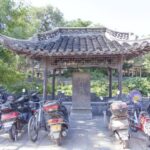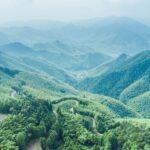Dajue Temple is located on the east side of Hengshan Reservoir in Yixing. It was first built during the Xianchun period of the Southern Song Dynasty (1265 – 1274 AD) and has a history of more than 700 years. Master Hsing Yun, a modern and contemporary eminent monk and the founding abbot of Fo Guang Shan, was ordained here. The temple was destroyed during the Cultural Revolution. The temple we see now is rebuilt in modern times under the auspices of Master Hsing Yun. The main road of Dajue Temple is in the shape of a ‘T’. The gate is at the left end of the horizontal stroke of the ‘T’. From west to east, from the temple gate to the pagoda forms the horizontal stroke of the ‘T’. From north to south, from the Guanyin Hall to the Grand Buddha Hall forms the vertical stroke of the ‘T’. The lotus pond in front of the Guanyin Hall is the intersection of the horizontal and vertical strokes. Tour the horizontal stroke first and then the vertical stroke to easily visit the entire Dajue Temple. In front of the temple gate stands an Ashoka pillar. Entering the gate is a long avenue. On the right side of the avenue are statues of arhats. On the left side is a corridor wall carved with colorful flying apsaras and Buddhas. At the end of the avenue is a statue of Master Hsing Yun. A little further ahead is the pagoda. Returning to the Guanyin Hall, the walls inside the hall are covered with small bodhisattvas in grids. The colors are fresh. The several large bodhisattvas standing by the wall have an Indian style. Looking at the Grand Buddha Hall to the south from the Guanyin Hall has an open view. The Grand Buddha Hall is on a slightly higher ground and is very magnificent. Climbing up the wide steps, it doesn’t take long to reach the Grand Buddha Hall. Inside the hall, a jade statue of Sakyamuni is enshrined. The carvings on the walls on both sides of the jade statue are very beautiful. The side rooms next to the Grand Buddha Hall are Master Hsing Yun’s places, which contain his calligraphy and books. The Dishuifang on the ground floor of the Guanyin Hall serves vegetarian food. In addition to staple foods such as vegetarian noodles, it also provides tea and pastries. Opening hours: Open all year round from 8:00 to 17:00.
Dajue Temple, the Ancestral Court of Buddha’s Light
Dajue Temple is located on the east side of Hengshan Reservoir in Yixing. It was first built during [...]









